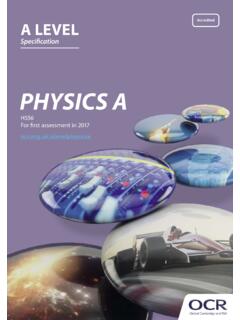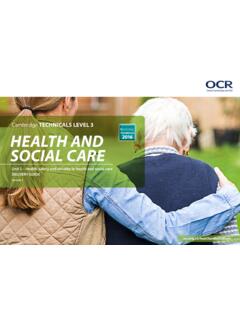Transcription of Cambridge TECHNICALS LEVEL 3 HEALTH AND SOCIAL CARE
1 Unit 4 Anatomy and physiology for HEALTH and SOCIAL careDELIVERY GUIDEV ersion 1 Cambridge TECHNICALS LEVEL 3 HEALTH AND SOCIAL TECHNICALS IN HEALTH AND SOCIAL CARELEVEL 3 UNIT 42 CONTENTSI ntroduction 3 Related Activities 4 Key Terms 5 Misconceptions 12 Suggested Activities: Learning Outcome (LO1) 16 Learning Outcome (LO2) 19 Learning Outcome (LO3) 21 Learning Outcome (LO4) 23 Learning Outcome (LO5) 24 Learning Outcome (LO6) 27 Cambridge TECHNICALS IN HEALTH AND SOCIAL CARELEVEL 3 UNIT 433 INTRODUCTIONThis Delivery Guide has been developed to provide practitioners with a variety of creative and practical ideas to support the delivery of this qualification. The Guide is a collection of lesson ideas with associated activities, which you may find helpful as you plan your lessons.
2 OCR has collaborated with current practitioners to ensure that the ideas put forward in this Delivery Guide are practical, realistic and dynamic. The Guide is structured by learning outcome so you can see how each activity helps you cover the requirements of this unit. We appreciate that practitioners are knowledgeable in relation to what works for them and their learners. Therefore, the resources we have produced should not restrict or impact on practitioners creativity to deliver excellent learning opportunities. Whether you are an experienced practitioner or new to the sector, we hope you find something in this guide which will help you to deliver excellent learning opportunities. If you have any feedback on this Delivery Guide or suggestions for other resources you would like OCR to develop, please email Please note The timings for the suggested activities in this Delivery Guide DO NOT relate to the Guided Learning Hours (GLHs) for each unit.
3 Assessment guidance can be found within the Unit document available from The latest version of this Delivery Guide can be downloaded from the OCR 4 Anatomy and physiology for HEALTH and SOCIAL careLO1 Understand the cardiovascular system, malfunctions and their impact on individualsLO2 Understand the respiratory system, malfunctions and their impact on individualsLO3 Understand the digestive system, malfunctions and their impact on individualsLO4 Understand the musculoskeletal systems, malfunctions and their impact on individualsLO5 Understand the control and regulatory systems, malfunctions and their impact on individualsLO6 Understand the sensory systems, malfunctions and their impact on individualsTo find out more about this qualification please go to: AIMWe eat, we breathe and we control our bodies, as well as responding to the external environment, but why and how?
4 This unit will help you to understand why these essential processes are so important in maintaining life. You will learn not only about the structure and function of some of the cells and tissues involved, but how they form organs and body systems that then have to interact to ensure that the body can provide the conditions necessary for thought, co-ordination, movement and unit aims to introduce you to the basic structure and functions of the body systems involved in everyday activities and maintenance of HEALTH , including cardiovascular, respiratory and digestive systems. You will also understand the part played by organs such as the pancreas, liver and kidney. You will investigate the systems and organs involved in detecting and responding to change such as the nervous system as well as the eyes and , things do go wrong and each system has well-known diseases and disorders.
5 Also, as individuals grow older, they are likely to be affected by malfunctions as a result of degeneration. Some of these will simply be inconvenient; others will be life-changers. You will understand the effects on individuals and what has to be done on a daily basis to enable them to lead as full and independent a life as FOR ENGLISH AND MATHS SKILLS DEVELOPMENT AND WORK EXPERIENCEWe believe that being able to make good progress in English and maths is essential to learners in both of these contexts and on a range of learning programmes. To help you enable your learners to progress in these subjects, we have signposted opportunities for English and maths skills practice within this resource. We have also identified any potential work experience opportunities within the activities. These suggestions are for guidance only. They are not designed to replace your own subject knowledge and expertise in deciding what is most appropriate for your learners.
6 English Maths WorkCAMBRIDGE TECHNICALS IN HEALTH AND SOCIAL CARELEVEL 3 UNIT 44 This unit (Unit 4)Title of suggested activityOther units/LOsLO1 The heart and the lymphatic systemUnit 10 Nutrition for healthLO3 Understand factors which influence nutritional healthUnit 14 The impact of long-term physiological conditionsLO1 Know what long-term physiological conditions are, their causes and symptoms and LO2 Understand effects of long-term physiological conditionsUnit 15 Promoting HEALTH and wellbeingLO1 Understand reasons for maintaining a healthy lifestyleUnit 18 Caring for older peopleLO1 Understand the ageing processLO2 Respiratory processesUnit 14 The impact of long term physiological conditionsLO1 Know what long-term physiological conditions are.
7 Their causes and symptoms and LO2 Understand effects of long-term physiological conditionsUnit 15 Promoting HEALTH and wellbeingLO1 Understand reasons for maintaining a healthy lifestyleUnit 18 Caring for older peopleLO1 Understand the ageing processLO3 Digestive conditionsUnit 10 Nutrition for healthLO3 Understand factors which influence nutritional healthUnit 14 The impact of long-term physiological conditionsLO1 Know what long-term physiological conditions are, their causes and symptoms and LO2 Understand effects of long-term physiological conditionsUnit 15 Promoting HEALTH and wellbeingLO1 Understand reasons for maintaining a healthy lifestyleUnit 18 Caring for older peopleLO1 Understand the ageing processLO4 Arthritis and osteoporosisUnit 14 The impact of long-term physiological conditionsLO1 Know what long-term physiological conditions are, their causes and symptoms and LO2 Understand effects of long-term physiological conditionsUnit 15 Promoting HEALTH and wellbeingLO1 Understand reasons for maintaining a healthy lifestyleUnit 18 Caring for older peopleLO1 Understand the ageing processLO5 CNS and endocrine related conditionsUnit 14 The impact of long-term physiological conditionsLO1 Know what long-term physiological conditions are, their causes and symptoms and LO2 Understand effects of long-term physiological conditionsUnit 15 Promoting HEALTH and wellbeingLO1 Understand reasons for maintaining a healthy lifestyleUnit 18 Caring for older peopleLO1 Understand the ageing processLO6 The eye and associated conditions and treatmentsUnit 14 The impact of long-term physiological conditionsLO1 Know what long-term physiological conditions are.
8 Their causes and symptoms and LO2 Understand effects of long-term physiological conditionsUnit 18 Caring for older peopleLO1 Understand the ageing processLO6 The ear and associated conditions and treatmentsUnit 14 The impact of long-term physiological conditionsLO1 Know what long-term physiological conditions are, their causes and symptoms and LO2 Understand effects of long-term physiological conditionsUnit 18 Caring for older peopleLO1 Understand the ageing processThe Suggested Activities in this Delivery Guide listed below have also been related to other Cambridge TECHNICALS in HEALTH and SOCIAL Care units/Learning Outcomes (LOs). This could help with delivery planning and enable learners to cover multiple parts of units. RELATED ACTIVITIESCAMBRIDGE TECHNICALS IN HEALTH AND SOCIAL CARELEVEL 3 UNIT 45 KEY TERMSE xplanations of the key terms used within this unit, in the context of this unitKey termExplanationAbsorptionThe process through which digested food is absorbed in the small intestine and into the glandsThese consist of two organs that are located on top of the kidneys and that produce hormones.
9 The adrenal glands are divided into an outer part called the cortex and an inner part called the medulla. The adrenal cortex produces essential hormones such as aldosterone: a hormone that helps to control blood pressure. The adrenal medulla produces non-essential hormones such as adrenaline: a hormone that helps the body react to respirationThe respiration process involves releasing energy for cells from glucose. Aerobic respiration requires are located within the lungs (at the end of bronchioles) and consist of tiny air sacs through which oxygen from the air gets into the blood and waste carbon dioxide from the blood is removed out into the macular degeneration (AMD) is an eye condition that affects the back part of the eye, called the macula. The exact cause is unknown. AMD affects your central vision; symptoms may include a reduced ability to see small detail when reading small print or watching television, and blurred are the widened parts located within the semi-circular canals of the ear.
10 Tiny hairs are contained within ampullae that help the brain to detect any head motion; this is crucial for maintaining respirationThe respiration process involves releasing energy for cells from glucose. Anaerobic respiration does not require aorta is the largest artery in the body. It carries oxygenated blood away from the are blood vessels that transport blood rich in oxygen away from the heart. ArthritisA condition that causes inflammation and pain in the joints; it affects both adults and children. Osteoarthritis and rheumatoid arthritis are the two most common process through which digested and absorbed food molecules are taken and used by the cells in the technologyAssistive technology includes any device, piece of equipment or system that allows an individual to carry out a task that they would otherwise be unable to do, or helps with ensuring their safety whilst doing it.












